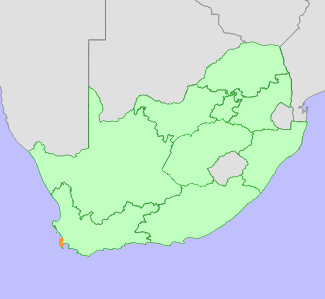|
Scientific Name | Aspalathus capitata L. |
Higher Classification | Dicotyledons |
Family | FABACEAE |
Synonyms | Achyronia capitata (L.) Kuntze, Aspalathus glomerata L.f., Paraspalathus capitata (L.) C.Presl |
National Status |
Status and Criteria | Vulnerable D1 |
Assessment Date | 2021/04/04 |
Assessor(s) | N.A. Helme & D. Raimondo |
Justification | This species is listed as Vulnerable. The extent of occurrence (EOO) is very restricted at 196 - 276 km², and the population is very small (<1,000 mature individuals). Although protected and not currently declining, the population is vulnerable to reinvasions of alien species if current levels of management are not maintained. |
Distribution |
Endemism | South African endemic |
Provincial distribution | Western Cape |
Range | This species is a South African endemic, known only from the Western Cape. It is found on the Cape Peninsula, Table Mountain, Constantiaberg and Muizenberg. |
Habitat and Ecology |
Major system | Terrestrial |
Major habitats | Peninsula Sandstone Fynbos |
Description | Plants grow in slopes in sandstone fynbos. |
Threats |
| While the population occurs entirely within the Table Mountain National Park, parts of its range were however formerly infested with alien invasive plants, these were cleared between 2005 and 2015. iNaturalist observations between 2017 and 2021 note that invasive acacias still occur within the vicinity of certain stands. Ongoing alien clearing is carried out by South African National Parks and thus invasives are not currently causing population decline, they do however remain a future potential threat. |
Population |
This species occurs as scattered individuals or as small clumps of between 10 and 50 plants within a very limited area (196 - 276 km²). It is estimated that the population numbers fewer than 1000 mature individuals in four subpopulations. Ongoing monitoring by citizen scientists posting on iNaturalist shows that the population is not declining.
|
Population trend | Stable |
Assessment History |
Taxon assessed |
Status and Criteria |
Citation/Red List version | | Aspalathus capitata L. | VU D1 | Raimondo et al. (2009) | | Aspalathus capitata L. | Insufficiently Known | Hilton-Taylor (1996) | |
Bibliography |
Dahlgren, R. 1988. Crotalarieae (Aspalathus). In: O.A. Leistner (ed). Flora of southern Africa 16 Fabaceae, Part 3 Papilionoideae, Fascicle 6:1-430. National Botanical Institute, Pretoria.
Goldblatt, P. and Manning, J.C. 2000. Cape Plants: A conspectus of the Cape Flora of South Africa. Strelitzia 9. National Botanical Institute, Cape Town.
Helme, N.A. and Trinder-Smith, T.H. 2006. The endemic flora of the Cape Peninsula, South Africa. South African Journal of Botany 72(2):205-210.
Hilton-Taylor, C. 1996. Red data list of southern African plants. Strelitzia 4. South African National Botanical Institute, Pretoria.
Raimondo, D., von Staden, L., Foden, W., Victor, J.E., Helme, N.A., Turner, R.C., Kamundi, D.A. and Manyama, P.A. 2009. Red List of South African Plants. Strelitzia 25. South African National Biodiversity Institute, Pretoria.
|
Citation |
| Helme, N.A. & Raimondo, D. 2021. Aspalathus capitata L. National Assessment: Red List of South African Plants version 2024.1. Accessed on 2025/10/26 |
 Comment on this assessment
Comment on this assessment


